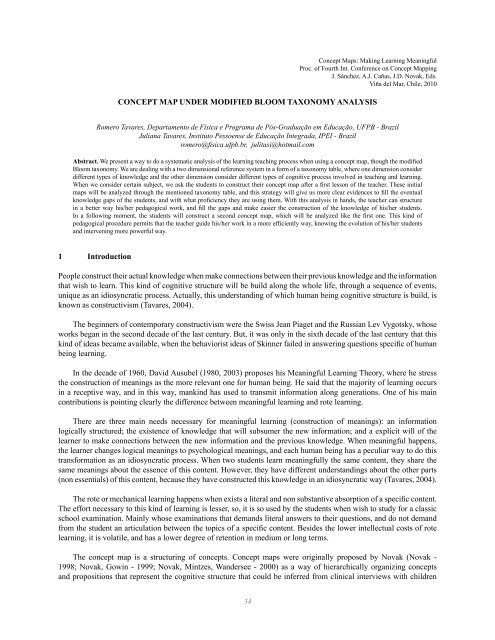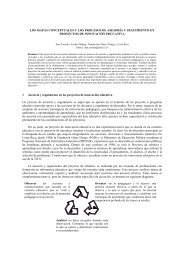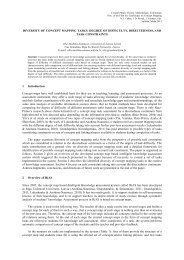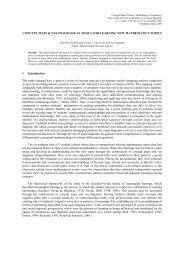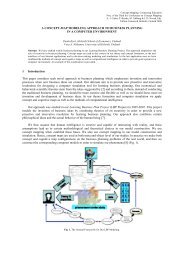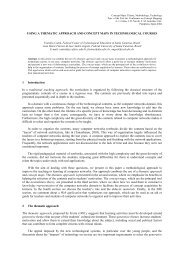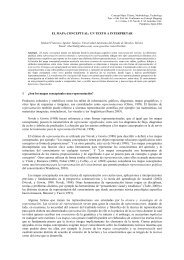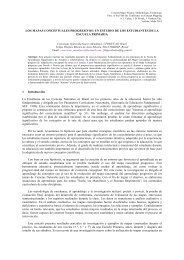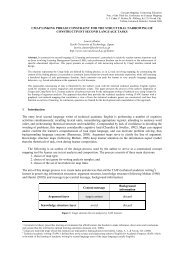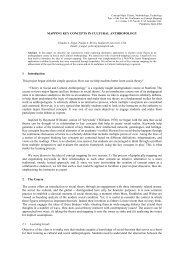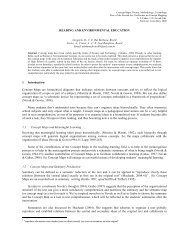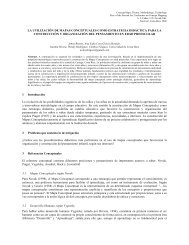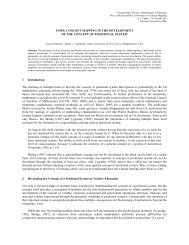Concept map under modified bloom taxonomy analysis
Concept map under modified bloom taxonomy analysis
Concept map under modified bloom taxonomy analysis
You also want an ePaper? Increase the reach of your titles
YUMPU automatically turns print PDFs into web optimized ePapers that Google loves.
<strong>Concept</strong> Maps: Making Learning Meaningful<br />
Proc. of Fourth Int. Conference on <strong>Concept</strong> Mapping<br />
J. Sánchez, A.J. Cañas, J.D. Novak, Eds.<br />
Viña del Mar, Chile, 2010<br />
concept <strong>map</strong> <strong>under</strong> <strong>modified</strong> <strong>bloom</strong> <strong>taxonomy</strong> <strong>analysis</strong><br />
Romero Tavares, Departamento de Física e Programa de Pós-Graduação em Educação, UFPB - Brazil<br />
Juliana Tavares, Instituto Pessoense de Educação Integrada, IPEI - Brazil<br />
romero@fisica.ufpb.br, julitasi@hotmail.com<br />
Abstract. We present a way to do a systematic <strong>analysis</strong> of the learning teaching process when using a concept <strong>map</strong>, though the <strong>modified</strong><br />
Bloom <strong>taxonomy</strong>. We are dealing with a two dimensional reference system in a form of a <strong>taxonomy</strong> table, where one dimension consider<br />
different types of knowledge and the other dimension consider different types of cognitive process involved in teaching and learning.<br />
When we consider certain subject, we ask the students to construct their concept <strong>map</strong> after a first lesson of the teacher. These initial<br />
<strong>map</strong>s will be analyzed through the mentioned <strong>taxonomy</strong> table, and this strategy will give us more clear evidences to fill the eventual<br />
knowledge gaps of the students, and with what proficiency they are using them. With this <strong>analysis</strong> in hands, the teacher can structure<br />
in a better way his/her pedagogical work, and fill the gaps and make easier the construction of the knowledge of his/her students.<br />
In a following moment, the students will construct a second concept <strong>map</strong>, which will be analyzed like the first one. This kind of<br />
pedagogical procedure permits that the teacher guide his/her work in a more efficiently way, knowing the evolution of his/her students<br />
and intervening more powerful way.<br />
1 Introduction<br />
People construct their actual knowledge when make connections between their previous knowledge and the information<br />
that wish to learn. This kind of cognitive structure will be build along the whole life, through a sequence of events,<br />
unique as an idiosyncratic process. Actually, this <strong>under</strong>standing of which human being cognitive structure is build, is<br />
known as constructivism (Tavares, 2004).<br />
The beginners of contemporary constructivism were the Swiss Jean Piaget and the Russian Lev Vygotsky, whose<br />
works began in the second decade of the last century. But, it was only in the sixth decade of the last century that this<br />
kind of ideas became available, when the behaviorist ideas of Skinner failed in answering questions specific of human<br />
being learning.<br />
In the decade of 1960, David Ausubel (1980, 2003) proposes his Meaningful Learning Theory, where he stress<br />
the construction of meanings as the more relevant one for human being. He said that the majority of learning occurs<br />
in a receptive way, and in this way, mankind has used to transmit information along generations. One of his main<br />
contributions is pointing clearly the difference between meaningful learning and rote learning.<br />
There are three main needs necessary for meaningful learning (construction of meanings): an information<br />
logically structured; the existence of knowledge that will subsumer the new information; and a explicit will of the<br />
learner to make connections between the new information and the previous knowledge. When meaningful happens,<br />
the learner changes logical meanings to psychological meanings, and each human being has a peculiar way to do this<br />
transformation as an idiosyncratic process. When two students learn meaningfully the same content, they share the<br />
same meanings about the essence of this content. However, they have different <strong>under</strong>standings about the other parts<br />
(non essentials) of this content, because they have constructed this knowledge in an idiosyncratic way (Tavares, 2004).<br />
The rote or mechanical learning happens when exists a literal and non substantive absorption of a specific content.<br />
The effort necessary to this kind of learning is lesser, so, it is so used by the students when wish to study for a classic<br />
school examination. Mainly whose examinations that demands literal answers to their questions, and do not demand<br />
from the student an articulation between the topics of a specific content. Besides the lower intellectual costs of rote<br />
learning, it is volatile, and has a lower degree of retention in medium or long terms.<br />
The concept <strong>map</strong> is a structuring of concepts. <strong>Concept</strong> <strong>map</strong>s were originally proposed by Novak (Novak -<br />
1998; Novak, Gowin - 1999; Novak, Mintzes, Wandersee - 2000) as a way of hierarchically organizing concepts<br />
and propositions that represent the cognitive structure that could be inferred from clinical interviews with children<br />
34
who were part of an educational project which he directed. Novak and his research group was faced with numerous<br />
recordings of clinical interviews that assessed the conceptual evolution of students´ knowledge about basic subjects of<br />
natural science, and found the <strong>map</strong> as a way of imaging concepts and their connections present in a particular person<br />
cognitive structure.<br />
However, assess and <strong>map</strong> the cognitive structure of someone is only one possible utilities of this educational tool<br />
(Tavares, Rodrigues – 2007). Analyze a conceptual of an expert on a certain content is a great way to start a study<br />
on this topic, as we are explaining the relevant connections between important concepts, in addition to showing an<br />
overview of the topic. On the other hand, when the beginner is building your own <strong>map</strong>, he is both elucidating and<br />
explicating his knowledge. This process itself, will demonstrate its advantages and difficulties in <strong>under</strong>standing the<br />
concepts of the topic ender studying. Each time he takes a radiograph of his <strong>under</strong>standing of the subject and can<br />
return to the sources of the subject of information to clarify doubts, answer his questions and thus can build his own<br />
knowledge (Tavares – 2007).<br />
2 Modified Bloom <strong>taxonomy</strong> and meaningful learning<br />
The <strong>taxonomy</strong> of educational objectives is a reference to classify claims <strong>under</strong> which we expect or desire that students<br />
learn as a result of instruction. This bench mark was designed as a way to facilitate the exchange of school tests<br />
between faculties of several American universities, and this exchange consider building a bank of tests, each assessing<br />
the same educational goals.<br />
Benjamin Bloom started the idea, hoping it would reduce the labor of preparing the annual examinations. Whereas<br />
development of multiple choice questions of good quality requires a large investment of time examiners always<br />
dream of being able to exchange among themselves issues previously developed, thus avoiding duplication of efforts.<br />
They proposed to establish a standard vocabulary for each topic that discussion was desired to evaluate, measure.<br />
These meanings originate from a regular set of careful definition of categories and sub categories, within which any<br />
educational goal and therefore, each topic could be ranked (Anderson et alli – 2001). T reduce this effort, he listed a<br />
group of experts, and this group met twice a year beginning in 1949. A final draft of work was published in 1956 <strong>under</strong><br />
the title of “Taxonomy of Educational Objectivies: The Classification of Educational Goals. Handbook I: Cognitive<br />
Domain.<br />
The original <strong>taxonomy</strong> has provided careful definitions for each six major categories of cognitive domain. These<br />
categories were: knowledge, comprehension, application, <strong>analysis</strong>, synthesis and evaluation (Krathwohl – 2002).<br />
The <strong>modified</strong> Bloom Taxonomy considers the learning and teaching process as a two-dimensional frame, where<br />
one dimension is just the several forms of knowledge. Each type of knowledge is considered according to the cognitive<br />
processes with which they can be build.<br />
The knowledge<br />
dimension<br />
A. Factual knowledge<br />
B. <strong>Concept</strong>ual<br />
knowledge<br />
C. Procedural knowledge<br />
D. Meta-cognitive<br />
knowledge<br />
The cognitive process dimension<br />
1. Remember 2. Understand 3. Apply 4. Analyze 5. Evaluate 6. Create<br />
Table 1. Bloom <strong>modified</strong> <strong>taxonomy</strong> Table(Anderson el al, 2001)<br />
Each pedagogical task can be planned or analyzed though this <strong>taxonomy</strong> table, and certain attitude correspond to<br />
a dot (or square) in this bench mark.<br />
The meaningful learning relates the construction of meaning, in other words, the transformation of logical meaning<br />
in psychological meaning. We are considering how the information that is offered to the learner is transformed in<br />
knowledge, as it restructures prior knowledge, which is replaced by a new network of connections and symbolic<br />
meanings. This meaningful learning is related to the learner active participation building his own knowledge, and if<br />
35
we make a parallel with the taxonomic Tablepresented in Table1, it is related to cognitive processes of <strong>under</strong>stand,<br />
apply, analyze, evaluate and create.<br />
Moreover, the rote learning, highlighted by Ausubel, deals primarily with the process of remembering,<br />
remembering factual knowledge or any other kind of knowledge. The <strong>modified</strong> Bloom <strong>taxonomy</strong> considers in detail<br />
the subject treated by Ausubel theory, and in particular the subject dealt in concept <strong>map</strong>s proposed by Novak.<br />
3 <strong>Concept</strong> <strong>map</strong> <strong>under</strong> <strong>modified</strong> Bloom <strong>taxonomy</strong> <strong>analysis</strong><br />
The <strong>modified</strong> Bloom <strong>taxonomy</strong> provides a powerful tool to elucidate the characteristics of a conceptual <strong>map</strong>.<br />
Considering what kind of knowledge is dealing given <strong>map</strong>, we can design a specific educational intervention for the<br />
teaching learning process of the author of the mentioned concept <strong>map</strong>.<br />
A concept <strong>map</strong> typical of someone who has little maturity with a theme is basically to recall factual knowledge.<br />
Eventually it may even consider other types of knowledge, but always emphasizes the remembrance of such knowledge.<br />
A concept <strong>map</strong> itself gives a qualitative Figure of the cognitive structure of its author on the topic considered.<br />
This <strong>map</strong> reminds us of an <strong>analysis</strong> concerning the scope, depth and connectivity. The scope of a concept <strong>map</strong> means<br />
the exposure of the various facets of a subject; the depth means the proficiency in each of these facets (progressive<br />
differentiation); and connectivity concerns the connection of those facets (integrative reconciliation).<br />
The <strong>modified</strong> Bloom <strong>taxonomy</strong> provides a new way of looking at concepts <strong>map</strong>s: what are the cognitive processes<br />
used in the construction of each type of knowledge.<br />
Through this <strong>taxonomy</strong> we have an <strong>analysis</strong> about what cognitive processes and kinds of knowledge were used<br />
in a given <strong>map</strong>. And in doing so, we can intervene deliberately to achieve the results planned initially for the learning<br />
and teaching process.<br />
The construction of another concept <strong>map</strong> in later times will aim to systematize and stabilize the cognitive structure<br />
of the learner in spite of the new information discussed earlier.<br />
Figure 1. The first concept <strong>map</strong>.<br />
Figure 2. The second concept <strong>map</strong>.<br />
36
4 Methodology<br />
Using the construction of a concept <strong>map</strong> as a instructional tool means a paradigm shift. The western educational<br />
system utilizes in an intense way of teaching and learning based mainly on rote learning (memorization and retrive),<br />
as a literal learning. The use of concept <strong>map</strong> induces the student to construct symbolic relations between the various<br />
concepts of a particular content.<br />
For this study, the activities were developed in a class of 8 th grade in Elementary School, with the overall content<br />
of “The Initial Period of Organic Changes” (Puberty and Adolescence), attended by 30 students of both sexes and aged<br />
between 12 and 13 years. With a total of 95% frequency in the classroom, 17 students participated in the construction<br />
of three concept <strong>map</strong>s. Considering this study as a qualitative one, we selected the results of one student that illustrates<br />
more clearly the progress made by group facing the educational techniques used.<br />
The investigation was performed in three consecutive stages: planning lessons and resources to be used; evaluation<br />
of concept <strong>map</strong>s constructed by students; and the adequacy of re-planning as a result of the <strong>analysis</strong> according to the<br />
Modified Bloom´s Taxonomy.<br />
In the fist stage was presented a conceptual class “Changes in Adolescence”, where the information was<br />
presented using chalk and blackboard as an unique educational resource. The discussions on the topic considered were<br />
encouraged, and a moment later the students were asked to construct their concept <strong>map</strong>s on classroom content. To the<br />
extent that using the concept <strong>map</strong> as an analytical tool in the learning process while it is happening, this procedure is<br />
configured as a formative assessment, as opposed to traditional summative evaluation at end-stage school.<br />
Figure 3. The third concept <strong>map</strong>.<br />
In the second step, we analyzed these concept <strong>map</strong>s using Bloom´s <strong>modified</strong> <strong>taxonomy</strong> Table(Table 1) seeking<br />
guidance on how it was the student learning, and what cognitive processes and types of knowledge that would still be<br />
required to develop. Considering the cognitive development observed in classroom, it was planned a second and third<br />
classes with the additional use of images about the considered content. At the end of the second class, the students<br />
constructed the second concept <strong>map</strong> as a way to follow the transformations that might occur. The results showed little<br />
changes, little significant results comparing with previous concept <strong>map</strong>, and we realized the need of different pedagogical<br />
resources to stimulate a contextualization and <strong>under</strong>standing of the subject. It was planned to classes 4, 5 and 6 with<br />
37
interactive lecture given by a pediatrician about puberty and adolescence, followed by a dynamic where everyone should<br />
customize a chicken egg and bear it for three days. After that, the discussions were focused on the posture of each one<br />
about their, their experience and their feelings. Thus, the third phase of research consisted of the third concept <strong>map</strong>. Just<br />
like the previous <strong>map</strong>s, the group constructed these <strong>map</strong>s on the same topic, without having access to the previous <strong>map</strong>s.<br />
In constructing the first concept <strong>map</strong> (Figure 1) was observed exclusively the presence of factual and conceptual<br />
knowledge, and cognitive dimensions of remember and <strong>under</strong>stand. This result represents a student behavior rather<br />
superficial on the content, but showed only an initial moment of the approach. Considering the subject worked, and<br />
because the children are experiencing this period (or approaching this period) of transformations of their body and<br />
minds, can be concluded that they had few opportunities to develop this knowledge in a contextualized and mature way.<br />
In constructing the second concept <strong>map</strong> (Figure 2) was more common the emergence of associated concepts, new<br />
connections, more information on the subject, the greater number of factual knowledge and different systematization.<br />
Thus, it can be seen an extension of the results where appears the cognitive dimension.<br />
Finally, we can say that the procedure described in this work open the possibility of evaluating the teaching learning<br />
process through concept <strong>map</strong>, according to the <strong>modified</strong> Boom <strong>taxonomy</strong>. In other words, we can now quantify the<br />
structure of various types of knowledge and cognitive process used by each student. We also analyze a class of students<br />
on a global basis, according to the systematization mentioned.<br />
Moreover the construction of concept <strong>map</strong>s can be inserted within a formative assessment where the steps are<br />
designed after analyzing the taxonomic table, and therefore having a clear perception of the stages where the students<br />
are.<br />
5 Conclusions<br />
To follow the cognitive development of the students, the construction of the concept <strong>map</strong>s show the elements that form<br />
(constitute) the cognitive structure of them about a specific content. We can observe the deep and extension of their<br />
knowledge analyzing the interrelationship of the concepts uses in their <strong>map</strong>s. But to make use of concept <strong>map</strong>s in school<br />
evaluation process we need to be aware to the treatment given to this instrument.<br />
We observe that concept <strong>map</strong> is not sufficient to measure the level of gained knowledge, or to evaluate the<br />
development of this knowledge. With a pure observation alone of a concept <strong>map</strong>, the assessment criteria are likely to be<br />
subjective one. In this case, another different observer, will make a different assessment with its own opinion, and may<br />
classify the <strong>map</strong> of a student as adequate or inadequate form personal views.<br />
With this work, to extend the boundaries of the assessment, we used Modified Bloom´s <strong>taxonomy</strong> that uses<br />
the dimensions of knowledge and cognitive processes that govern a pedagogical event. It is clear seen how it was<br />
implemented, and the guidelines governing the evaluation processes used, allowing a much broader horizon than a<br />
simple observation.<br />
In five years of work in classroom using concept <strong>map</strong> as part of evaluation process, using only regular observation of<br />
the <strong>map</strong>s themselves, their constituents and connections, at no time were the results of students assessed with precision; in<br />
other words, assessment did not exhibit an increase of knowledge and knowledge about these elaborations. Differentially,<br />
when teacher makes use of the classification of the knowledge studied in class (factual, conceptual, procedural and metacognitive),<br />
this orientation pre-set aspects to be considered and guide a sequence of evaluations. If the teacher <strong>under</strong>stand<br />
and use in the evaluation, each step for which the student must pass in order to develop an appropriate knowledge, the<br />
teacher will widely promote the planning of resources to be used in classes.<br />
References<br />
Cañas, A. J., Ford, K. M., Coffey, J., Reichherzer, T., Carff, R., Shamma, D., & Breedy, M. (2000). Herramientas para<br />
Construir y Compartir Modelos de Conocimiento basados en Mapas <strong>Concept</strong>uales. Revista de Informática Educativa,<br />
13(2), 145-158.<br />
38
Chakrabarti, S., Dom, B., Gibson, D., Kleinberg, J., Raghavan, P., & Rajagopalan, S. (1998). Automatic Resource List<br />
Compilation by Analyzing Hyperlink Structure and Associated Text. Paper presented at the 7th International World<br />
Wide Web Conference.<br />
Novak, J. D. (1998). Learning, creating, and using knowledge: <strong>Concept</strong> Maps as Facilitative Tools in Schools and<br />
Corporations. Mahweh, NJ: Lawrence Erlbaum Associates.<br />
Novak, J. D., & Gowin, D. B. (1984). Learning How to Learn. New York: Cambridge University Press.<br />
Pearsall, N. R., Skipper, J., & Mintzes, J. (1997). Knowledge restructuring in the life sciences: a longitudinal study of<br />
conceptual change in biology. Science Education, 81(2), 193-215.<br />
Reynolds, S., & Dansereau, D. (1990). The knowledge hyper<strong>map</strong>: An alternative to hypertext. Computers in Education,<br />
14(5), 409-416.<br />
Spiro, R. J., Feltovich, P. J., Jacobson, J. J., & Coulson, R. L. (1992). Cognitive Flexibility, Constructivism, and Hypertext:<br />
Random Access Instruction for Advanced Knowledge Acquisition in Ill-Structured Domains. In T. M. Duffy & T. D.<br />
H. Jonassen (Eds.), Constructivism and the Technology of Instruction: A Conversation (pp. 57-75). Hillsdale, NH:<br />
Lawrence Erlbaum Associates.<br />
Tavares, Romero (2004) Aprendizagem Significativa. Revista Conceitos, 5, 55.<br />
Tavares, Romero (2007) Construindo Mapas Conceituais. Revista Ciência e Cognição, 12, 72.<br />
Tavares, Romero; Rodrigues, Gil Luna (2007) Mapas conceituais: Uma ferramenta pedagógica na consecução do currículo.<br />
Revista Principia, 15, 110.<br />
Tavares Romero; Rodrigues, Gil Luna; Andrade, Mariel; Santos, José Nazareno; Cabral,, Lucídio; Cruz, Henry Pôncio;<br />
Monteiro, Bruno; Gouveia, Thiago; Picado, Karin (2007) Objetos de aprendizagem: uma proposta de avaliação da<br />
aprendizagem significativa – in Carmem Lúcia Prata e Anna Christina Aun de Azevedo Nascimento (Eds) - Objetos<br />
de Aprendizagem - RIVED - Rede Interativa Virtual de Educação - ISBN: 978-85-296-0093-2 – Brasília.<br />
Wandersee, J. H., Mintzes, J. J., & Novak, J. D. (1994). Learning: Alternative <strong>Concept</strong>ions. In D. L. Gabel (Ed.), Handbook<br />
on Research in Science Teaching (pp. 177-210). New York: Macmillan.<br />
Willerman, M., & Mac Harg, R. A. (1991). The concept <strong>map</strong> as an advance organizer. Journal of Research in Science<br />
Teaching, 28(8), 705-711.<br />
Yates, R. B., & Ribeiro-Neto, B. (1999). Modern Information Retrieval. MA: Addison Wesley.<br />
39


